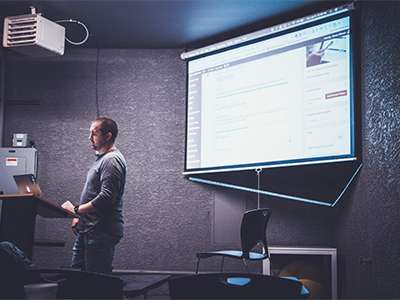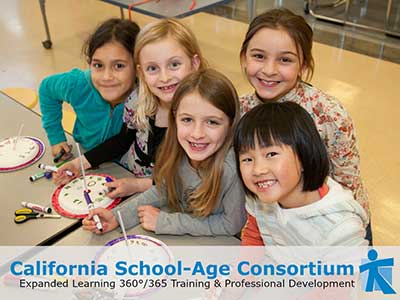 |
Safety and Survival in an Active Shooter Event |
1.00 |
An all too unfortunate reality is that active shooter events are occurring with alarming frequency throughout the world. This course is intended to make you aware of the steps you should take if you are ever involved in an active shooter event. |
 |
Project Teams: Communicating in a Project Team |
1.00 |
Although most people think of communication as the act of speaking, the act of receiving a message, or listening, is an extremely vital part of communication. Seventy to 90 percent of your time is spent listening, not speaking. Active listening includes not only hearing words that are spoken, but interpreting the verbal message and nonverbal communication as well.
During a project team meeting, you need to communicate with clarity to ensure that the entire team understands what is said.
In this course you will learn to: use good listening skills when communicating within a project team, understand and use good verbal communication skills and empowerment to communicate effectively within a project team, and receive and give feedback. |
 |
Project Teams: Communicating in a Project Team (Instructor Guide) |
1.00 |
Although most people think of communication as the act of speaking, the act of receiving a message, or listening, is an extremely vital part of communication. Seventy to 90 percent of your time is spent listening, not speaking. Active listening includes not only hearing words that are spoken, but interpreting the verbal message and nonverbal communication as well.
During a project team meeting, you need to communicate with clarity to ensure that the entire team understands what is said.
In this course you will learn to: use good listening skills when communicating within a project team, understand and use good verbal communication skills and empowerment to communicate effectively within a project team, and receive and give feedback.
This Instructor's Edition of this course includes notes and suggestions to assist you in presenting the material, whether in an in-person classroom setting, or as an instructor-led online or distance-learning course. It also provides you with the answers to questions found in mid-lesson activities, as well as in the quiz that concludes the course. |
 |
Advanced Interpersonal Communication: First Impressions and Building Rapport |
0.67 |
Although it only takes 30 to 45 seconds to formulate a first impression, it often requires four or five additional encounters to change someone's first impression. Many times, once you've made a first impression, you will not have a second opportunity to change that impression. Therefore, it's important to make your best impression on the first try.
In this course you will learn: to identify the elements that influence a first impression, to build rapport, and establish credibility with others, and to build positive relationships. |
 |
Advanced Interpersonal Communication: First Impressions and Building Rapport (Instructor Guide) |
0.67 |
Although it only takes 30 to 45 seconds to formulate a first impression, it often requires four or five additional encounters to change someone's first impression. Many times, once you've made a first impression, you will not have a second opportunity to change that impression. Therefore, it's important to make your best impression on the first try.
In this course you will learn: to identify the elements that influence a first impression, to build rapport, and establish credibility with others, and to build positive relationships.
This Instructor's Edition of this course includes notes and suggestions to assist you in presenting the material, whether in an in-person classroom setting or as an instructor-led online or distance-learning course. It also provides you with the answers to questions found in mid-lesson activities, as well as in the quiz that concludes the course. |
 |
Effective Presentations: Fundamentals of Persuasion (Instructor Guide) |
1.17 |
Although all presentations are persuasive to some extent, a true persuasive presentation attempts to influence the way audience members think about something or influence the way they behave.
This Instructor's Edition of this course includes notes and suggestions to assist you in presenting the material, whether in an in-person classroom setting, or as an instructor-led online or distance-learning course. It also provides you with the answers to questions found in mid-lesson activities, as well as in the quiz that concludes the course. |
 |
Cognitive Awareness |
1.00 |
All people have had specific experiences during their life that have shaped the way they think. This course is geared toward people dealing with faulty thinking and self-destructive behaviors due to past experiences. It is designed to help people learn how and why they think the way they do. It is also to teach cognitive skills to help with self-development. |
 |
Social-Emotional Learning and Enhancing Quality |
0.75 |
All children and youth need social- emotional and character skills in order to thrive in school, work, and life. By their design and structure, high-quality expanded learning and out-of-school time programs provide valuable opportunities for children and youth to develop such social-emotional and character skills. This course will introduce participants to social-emotional and character skills and their relationship to the California Quality Standards for Expanded Learning Programs. |
 |
Math Skills: Number Sense and Basic Algebra |
2.50 |
Algebra is a branch of mathematics dealing with symbols and the rules for manipulating those symbols. In this course, you will evaluate basic expressions, learn about common mathematical terms, use basic mathematical operations, solve word problems, and understand the basic properties of different types of numbers. |
 |
Shared Space 101 |
2.00 |
Afterschool programs share space and facilities that are used by other people and for other purposes during the school day. Learning how to accomplish this in a positive way is essential for effective programming. This course offers participants the opportunity to examine some common issues that can occur when sharing space, as well as strategies to effectively share space with a variety of people. |
 |
Customer Service: Responding |
1.00 |
After the greeting, listening, and questioning phases, the next phase is responding to a customer. Once you clearly understand a situation, your response will set the tone for the interaction. Without handling situations properly and without the right level of care, you can upset customers and ultimately drive them away. Responses must be timely and within expectations. If a customer is discussing a problem with you, then you know that at least one of that person’s expectations has not been met. |
 |
Strategic Decision Making: Decision Results |
0.84 |
After implementing a decision, you should review the process you followed to reach it, regardless of the outcome. There are guidelines that you can use to review and learn from your decisions. You also need to be aware of the various pitfalls to avoid when learning from your decisions.
You can improve your decision making skills by examining a variety of other sources, such as the experience of people in your company and the decisions of other companies. You should not overlook these opportunities, because they will improve your decision-making skills, and help you to avoid similar mistakes in the future.
In this course you will learn to: identify the guidelines to follow and pitfalls to avoid when reviewing your decisions, and identify actions you can take to learn from the experience of others. |
 |
Strategic Decision Making: Decision Results (Instructor Guide) |
0.84 |
After implementing a decision, you should review the process you followed to reach it, regardless of the outcome. There are guidelines that you can use to review and learn from your decisions. You also need to be aware of the various pitfalls to avoid when learning from your decisions.
You can improve your decision making skills by examining a variety of other sources, such as the experience of people in your company and the decisions of other companies. You should not overlook these opportunities, because they will improve your decision-making skills, and help you to avoid similar mistakes in the future.
In this course you will learn to: identify the guidelines to follow and pitfalls to avoid when reviewing your decisions, and identify actions you can take to learn from the experience of others.
This Instructor's Edition of this course includes notes and suggestions to assist you in presenting the material, whether in an in-person classroom setting or as an instructor-led online or distance-learning course. It also provides you with the answers to questions found in mid-lesson activities, as well as in the quiz that concludes the course. |
 |
Creating Community Collaborations |
2.00 |
Across the country, more and more communities are forming community collaborations to address the out-of-school needs of children and youth of all ages. When different segments of the community join together, share ideas, and pool their resources and efforts to create out-of-school time initiatives, children and youth benefit. What one organization or program may not be able to accomplish alone is often achievable when partnerships and collaborations among diverse groups and individuals are formed.
When school-age care professionals are knowledgeable about what it takes to create and sustain successful collaborations, they can play an important leadership role in creating out-of-school time initiatives and programs that will meet the needs of children and youth in their communities now and in the future. |
 |
Course 34: Creating Community Collaborations |
2.00 |
Across the country, more and more communities are forming community collaborations to address the out-of-school needs of children and youth of all ages. When different segments of the community join together, share ideas, and pool their resources and efforts to create OST initiatives, children and youth benefit. What one organization or program may not be able to accomplish alone, is often achievable when partnerships and collaborations among diverse groups and individuals are formed.
When OST professionals are knowledgeable about what it takes to create and sustain successful collaborations, they can play an important leadership role in creating OST initiatives and programs that will meet the needs of children and youth in their communities now and in the future.
|
 |
A Student Guide to Sexual Violence and the Law |
0.50 |
According to the US Department of Justice, an average of one in four undergraduate women experience sexual assault by the time they finish college. A series of federal laws empower colleges and universities to take action against sexual violence on campus. This course offers students a brief look at the Title IX, the Clery Act, the Violence Against Women Act, and the Campus Violence Elimination Act.
|
 |
Course 27: Exploring Ethics in School-Age Care: Focus on a Professional Code of Ethics |
2.00 |
According to Frank Loewenberg and Ralph Dolgoff, developing a code of ethics is a significant stage for any profession. “For most American occupational groups the development of a code of ethics coincided, more or less, with the decision to formalize the transformation of the occupation into a profession.” The transformation to a profession allows those working in the profession continuity and heightened sense of purpose. It allows those outside of the profession to realize the integrity and importance of the profession.
When OST/SAC professionals develop, adopt, and adhere to a Code of Ethics, they are guided by underlying principles that represent the values of the OST field. These underlying principles help them determine appropriate courses of action when they face ethical issues as they work with children, parents, colleagues, and community members. |
 |
Exploring Ethics in School-Age Care: Focus on a Professional Code of Ethics |
2.00 |
According to Frank Loewenberg and Ralph Dolgoff, developing a code of ethics is a significant stage for any profession. "For most American occupational groups the development of a code of ethics coincided, more or less, with the decision to formalize the transformation of the occupation into a profession." The transformation to a profession allows those working in the profession continuity and heightened sense of purpose. It allows those outside of the profession to realize the integrity and importance of the profession.
When SAC/OST professionals develop, adopt, and adhere to a Code of Ethics, they are guided by underlying principles that represent the values of the field. These underlying principles help them determine appropriate courses of action when they face ethical issues as they work with children, parents, colleagues, and community members. |
 |
Becoming a World Famous Mentor |
1.00 |
A world class employee mentoring program can build solidarity among your staff. It can help support stronger internal promotions from within your company, which is more cost-effective than recruiting outsiders. Mentoring creates better relationships between staff members, improves your bottom line by making your employees more efficient, and truly supports having a highly engaged workforce. Learn how the world famous San Diego Zoo put together a best-of-class Employee Mentoring Program, and how you can emulate this in your own company. |
 |
Managerial Leadership: Defining Employee Roles and Priorities |
1.50 |
A vision is created by an organization to inspire its members to work together to reach for an ideal of what the organization can become. The members of the organization should use the vision as the standard to determine the day-to-day functions of their individual roles. The vision is the guide to use every time an action is taken, a decision is made, or a plan is developed to improve the organization or the people in it. An organization’s vision should enable the members in every role to do what is in the best interest of the organization.
In this course you will learn to: determine leader roles and strengthen employee roles, and align employee priorities and evaluate employee performance. |
 |
Managerial Leadership: Defining Employee Roles and Priorities (Instructor Guide) |
1.50 |
A vision is created by an organization to inspire its members to work together to reach for an ideal of what the organization can become. The members of the organization should use the vision as the standard to determine the day-to-day functions of their individual roles. The vision is the guide to use every time an action is taken, a decision is made, or a plan is developed to improve the organization or the people in it. An organization’s vision should enable the members in every role to do what is in the best interest of the organization.
In this course you will learn to: determine leader roles and strengthen employee roles, and align employee priorities and evaluate employee performance.
This Instructor's Edition of this course includes notes and suggestions to assist you in presenting the material, whether in an in-person classroom setting or as an instructor-led online or distance-learning course. It also provides you with the answers to questions found in mid-lesson activities, as well as in the quiz that concludes the course. |
 |
Budgeting: Budgeting Fundamentals |
1.33 |
A typical budget contains information for a single year and is updated and revised periodically. Each company creates a budget that fits its unique needs. A budget can be used for many purposes, but its primary functions should be to support strategic goals and to help identify when actual results deviate from what was predicted. |
 |
Budgeting: Reviewing Budgets |
1.00 |
A typical budget contains information for a single year and is updated and revised periodically. Each company creates a budget that fits its unique needs. A budget can be used for many purposes, but its primary functions should be to support strategic goals and to help identify when actual results deviate from what was predicted. |
 |
Growth and Development of Preschoolers in Family Child Care (CDA 1) |
2.00 |
A supportive and healthy environment is key to promoting the growth and development of preschoolers. In this course, you will identify appropriate health and safety practices, examine how to develop developmentally appropriate activities, and explore how equipment and materials can help stimulate learning.
This course is designed to be part of a Child Development Associate (CDA) Credential™ curriculum. It covers CDA Subject Area 1: Planning a Safe, Healthy Environment to Invite Learning. This course can also be taken as a stand-alone learning event, or as part of a broader early childhood education curriculum.
|
 |
Mental Health First Aid in the Classroom |
1.00 |
A student shouts in rage, “I wish I were dead!” Is he expressing suicidal ideation? A student quickly covers cut marks over her left forearm. Should we approach her or respect her privacy?
The National Alliance on Mental Illness data show that one in five adolescents between the ages of 13 and 18 will experience a severe mental illness, and only 20 percent will receive treatment. We know, then, that our students are coming to us with mental health needs that are greater than ever before. This can feel overwhelming, especially when we want to help our students achieve to their fullest potential and are not sure how to.
The good news is that basic mental health first aid can offer practical, valuable tools. We don’t need to be a cardiac surgeon to perform CPR, and sometimes CPR can save a life. Similarly, we don’t have to be a licensed mental health professional to provide basic mental health first aid in the classroom.
|


























